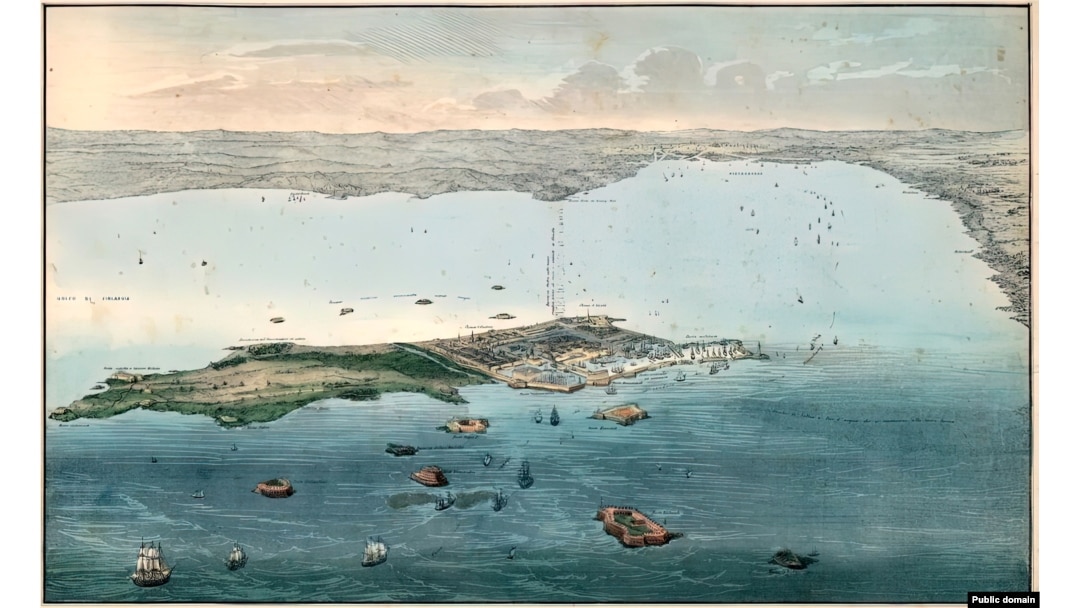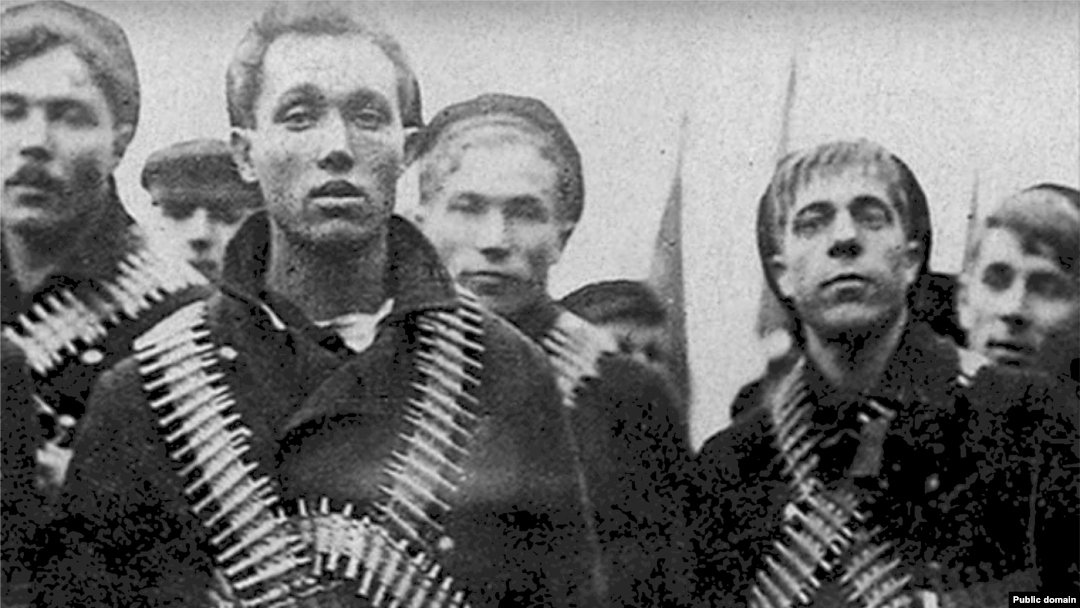A century ago, Lenin's communists turned their guns on rebelling sailors once hailed as the "pride and glory" of the Bolshevik Revolution.

Communist fighters advance across the frozen Gulf of Finland toward the port city of Kronstadt in March 1921.
This picture is one of only a handful in existence of a military victory over the mutinous sailors of Kronstadt that had "a shattering effect on socialists throughout the world" as the ruthless reality of Bolshevik rule was laid bare.

Kronstadt depicted in an 1853 painting
The island fortress of Kronstadt lies around 23 kilometers from the shores of St. Petersburg. It was founded by Peter the Great to defend maritime approaches to the former Russian capital.

Sailors of Kronstadt during the revolutionary unrest of 1917 pose with a flag vowing "Death to the bourgeoisie."
The naval fortress at Kronstadt had a long history of left-wing radicalism, rebellion, and sometimes shocking acts of vengeance. In 1917, after Russia's last tsar was overthrown, the disaffected sailors of Kronstadt seized the commander of the island fortress and bayonetted him to death.
Kronstadt sailors march in Petrograd (the name for St. Petersburg from 1914-24) in the summer of 1917, following the overthrow of Tsar Nicholas II.
After thousands of Kronstadt sailors backed Vladimir Lenin's Bolsheviks and helped them seize power during the 1917 revolution, the seamen were dubbed "the pride and glory of the revolution."
Young victims of a famine that devastated Russia from 1920-21
By 1921, four years of civil war that followed the Bolshevik Revolution, along with the ruthless management of Russia by its new communist rulers, had led to unfathomable human suffering.
When Kronstadt sailors were allowed to return to their villages on leave, they were confronted with the contrast between what Lenin's revolutionary socialism had promised and the horrors it delivered.
Starving villagers in the Volga region in 1920. A year earlier, Lenin had mandated the seizure of food from peasants to feed his army and supply Russian cities as part of a policy of "war communism."
One sailor recalled that "for years the happenings at home while we were at the front or at sea were concealed by the Bolshevik censorship. When we returned home, our parents asked us why we fought for the oppressors. That set us thinking."
With the civil war all but over, there was a perception that the ongoing suffering and repression no longer had any obvious justification.
The list of demands issued from the Kronstadt rebels in the spring of 1921 (click to enlarge)
On February 28, as thousands of workers in Petrograd were on strike, the Kronstadt sailors piled further pressure on the ruling Bolsheviks by issuing a list of demands, including the restoration of freedom of speech -- though only for their fellow radical leftists -- and for democratic elections.
As news of the rebellion spread, fear gripped Petrograd that mass political violence would break out anew.
Bolshevik Victor Serge recalled at the time seeing an old woman apparently leaving the city.
When he asked where she was going, she responded: "They're going to cut all your throats, my poor little ones. They're going to be looting everything all over again."
Kronstadt marines during the 1921 uprising
The Bolshevik response was to issue the sailors at Kronstadt a bloodcurdling ultimatum, threatening that if they did not surrender immediately, the rebels would be "shot like partridges."
Families of many of the sailors were then rounded up as hostages.
Bolshevik military commanders "discuss the suppression of the Kronstadt rebellion." A map of the island fortress can be seen in the background.
With spring approaching, the Bolshevik leadership worried that the ice around Kronstadt would melt. That would open the island fortress to resupply by sea and make the anti-communist stronghold virtually impossible to capture.
Leon Trotsky later recalled, "We were confronted by the danger that the ice would melt away and we were compelled to carry out the attack."
Red Army artillery works against the fort from the shores of the Gulf of Finland as the attack on Kronstadt begins.
On the evening of March 7, author and radical "communist anarchist" Alexander Berkman was walking along Petrograd's main street when he heard the distant boom of artillery. The Russian-American, whose fading hopes for an anarchist utopia had been revived by the Kronstadt rebellion, wrote in his diary: "My heart is numb with despair; something has died within me. The people on the street look bowed with grief.... The thunder of heavy guns rends the air."
Red Army airplanes are lined up on the frozen Gulf of Finland ahead of the attacks on Kronstadt. Poor weather hampered the use of the aircraft, and their bombing runs were largely ineffective.
The first infantry assault by around 20,000 men on Kronstadt was repulsed with the loss of thousands of communist troops. Many of the men plunged through the ice and drowned as artillery from Kronstadt shattered the ice underfoot.
But the communists regrouped and rounded up hard-line fighters for another, massive invasion force. Some of the men sang the socialist Internationale anthem as they headed toward the icy wastelands around Kronstadt. Other, less enthusiastic fighters were prodded onward by Bolshevik secret police armed with machine guns to discourage retreat.
At 3 a.m. on March 17, a silent invasion force of some 50,000 men crept across the ice from different directions. The attackers were under orders not to speak or light cigarettes as they stalked toward Kronstadt and its 15,000 exhausted defenders.
Bolshevik fighters, some dressed in white cloaks for camouflage, arrive on the outskirts of Kronstadt.
The final battle for Kronstadt raged from dawn throughout the day. The casualties, especially on the Bolshevik side after they had advanced without cover across the featureless ice, were appalling.
The Finnish government later requested that the thousands of corpses that lay atop the frozen gulf be removed to prevent their washing ashore in spring and causing an outbreak of disease.
Damage to the Petropavlosk battleship seen after the capture of Kronstadst. The ship was in the hands of the rebels throughout the uprising.
A Kronstadt sailor is questioned by Bolsheviks after the crushing of the rebellion.
The sailors who fell into Bolshevik hands were swiftly shot or sent to one of the early labor camps that would later become gulags. It is estimated some 2,000 Kronstadt sailors were executed, most without trial.
Victorious Red Army soldiers attend a ceremony aboard the Petropavlosk after the battle.
Many of the commanders of the communist fighters would eventually suffer the same fate as the sailors. Of the four Bolsheviks who led the suppression of Kronstadt, three were later executed during Stalin's "purges." The fourth, Leon Trotsky, was killed in exile by a Stalinist assassin armed with an ice pick.
Kronstadt sailors in Finland after escaping across the ice following the battle
Around 8,000 sailors were able to flee across the ice to nearby Finland. Years after the uprising, some of those escapees were promised an amnesty in Stalin's Soviet Union. The men who trusted the offer and returned to their homeland were sent to gulags or executed.


